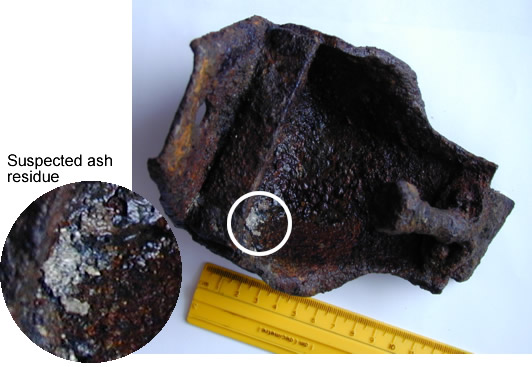Sampled Select Locations
One of the standard things that archaeologists do before selecting the exact location of the formal dig is to survey the area and take samples in a number of spots in the surrounding area.
Students noticed that the ground seemed softer at certain spots and at others they noticed a lot of mounds that may have been created naturally or could have been man-made. At N 50° 45.547', W 114° 19.527', students noted: "The soil felt like it had been dug on before. [The] ground was bubbled up like it had air pockets in it."
Parents used metal locators and marked where they found strong indications of possible finds. All of our observations helped us decide where to sample in preparation for our dig.
Chrome Ring and Gasket
|
Stove Leg
At one of our sample locations (N 50° 45.547', W 114° 19.528') in level 2 (10-20 cm) we found what appeared to be a stove leg with ashes inside it. There was a hole to attach it to the stove. Some of the parents who were volunteering with us could remember stoves legs like this. It was rusty, old and dirty. It was a pretty big stove leg and it was a weird shape. We think that this stove probably was used to heat their shack.

This validated the conclusions we had reached from our research and the interviews, especially the interview with Mrs. Prestie.
Square Enameled Metal
We couldn't come to agreement about this piece. Some of us think that it looks it might fit with the stove artifacts we found. We're wondering how this might have happened that different parts of a stove would be strewn all over the place. Could it be that wood stoves were thrown away if they switched to electricity? |
China ShardsWe think that the people who lived here (N 50° 45.542', W 114° 19.533') brought their plates from England because one of the china shards said "ENG" on the back. It looks like it says England written on yellow ribbon. The letters "DGW" are written going across the letters "ENG" and "REG" are written at the very top of the piece. It is the most important piece because it can tell us how old it is and where it came from. It is one of the smallest pieces we found but it can tell us the most out of all the pieces. We think that maybe a teacher lived close to where we dug because we found yellow chalk and paper too. When we talked to Andrea Richardson, she let us know that that there
were plate makers in North America around this time period but that bone
china mostly came from the orient and Europe. We aren't sure whether
all the shards were bone china or not. That is still a question we need
to research. |
Hinge
|
|

